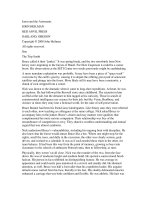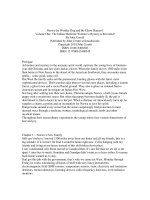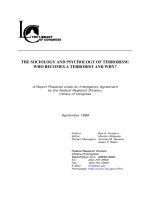The duke and the stars
Bạn đang xem bản rút gọn của tài liệu. Xem và tải ngay bản đầy đủ của tài liệu tại đây (3.78 MB, 387 trang )
The Duke and the Stars
astrology and politics
in renaissance milan
Monica Azzolini
i tatti studies in
italian renaissance history
Sponsored by Villa I Tatti
Harvard University Center for Italian Renaissance Studies
Florence, Italy
The Duke
and the Stars
Astrology and Politics
in Renaissance Milan
j
Monica Azzolini
harvard university press
Cambridge, Massachusetts
London, England
2013
Copyright © 2013 by the President and Fellows of Harvard College
All rights reserved
Printed in the United States of America.
Library of Congress Cataloging-in-Publication Data
Azzolini, Monica, 1971–
The duke and the stars : astrology and politics in Renaissance Milan /
Monica Azzolini.
p. cm.
Includes bibliographical references (p. 321) and index.
ISBN 978-0-674-06663-2â•… 1. Astrology and
politics—History.â•… 2. Gian Galeazzo Sforza, Duke of Milan, 1469–1494.â•…
3. Milan (Italy)—History—To 1535.â•… I. Title.
BF1729.P6A99 2012
133.50945'2109024—dc23â•…â•…â•… 2012015760
To A. C., S. K., K. P., and N. G. S.
Contents
Prefaceâ•…â•… ix
Illustrationsâ•…â•… xi
Introductionâ•…â•… 1
1 The Science of the Stars:
Learning Astrology at the University of Paviaâ•…â•… 22
2 The Making of a Dynasty:
Astrology under Bianca Maria Visconti and Francesco Sforzaâ•…â•… 65
3 Astrology Is Destiny:
Galeazzo Maria Sforza and the Political Uses of Astrologyâ•…â•… 100
4 The Star-Crossed Duke:
Gian Galeazzo Sforza and Medical Astrologyâ•…â•… 135
5 The Viper and the Eagle:
The Rise and Fall of Astrology under Ludovico Sforzaâ•…â•… 167
Epilogueâ•…â•… 210
viii
Abbreviationsâ•…â•… 215
Notesâ•…â•… 219
Bibliographyâ•…â•… 321
Acknowledgmentsâ•…â•… 355
Indexâ•…â•… 361
contents
Preface
This book is a study of the uses and function of astrological prediction in
one of the most sumptuous courts of the Italian Renaissance, the Sforza of
Milan. The research that eventually led to this book started with the casual
discovery of a large body of documents in the Archivio di Stato di Milano on
a sultry summer day back in 2002. A few weeks later—Â�armed with little
teaching experience and a bag full of hope and goodwill—Â�I left Europe for
the United States to take up my first academic post. Copies of the documents
travelled with me to Seattle, but only to lay there, virtually forgotten, for
another few years. Busy with teaching and life on a new continent, I worked
toward the publication of a couple of articles stemming from my doctoral
dissertation on the intellectual and social context of Leonardo da Vinci’s
anatomies in Milan. The plan, then, was to revise my doctoral dissertation to
turn it into a book. It was only when I moved to Sydney, Australia, in the fall
of 2004 that my plans changed and my research took an unexpected turn.
The nearest copies of Leonardo’s anatomical sheets were in Canberra, a full
one-�hour flight from where I taught. The archives that I used when writing
my doctorate were a good twenty-�one hours away. Conceiving of a plan B
became desirable and, increasingly, a necessity. I looked over my notes and
x
pr eface
the thousand copies of documents collected over the years, and there it was,
a stack of documents on astrology that I could barely decipher. There is no
name for the strange disease that takes over a scholar’s mind when intrigued
by what one cannot fully grasp (or at least no name exists that is truly flattering to that scholar!). No sooner had I landed my second job on another
continent—Â�this one further still from my archives—Â�that I was caught in the
grip of this nameless disease: I could barely decipher the symbols on many
of those pages and yet I wanted to make sense of those documents and tell
their story.
The rehabilitation of astrology—Â�one of the infamous “wretched subjects”
of pre-Â�modern societies—Â�in Renaissance and Early Modern Studies is now
almost complete. Astrology is no longer shunned by serious academics.
Astrologers have been the subject of entire monographs, and in recent decades
there has been a steady flow of works exploring the intellectual tenets of the
discipline. Astrology’s relationship with political power, especially in a courtly
context, however, has yet to receive organic treatment, and the role of the
court astrologer still awaits a major study. In particular, very little attention
has been paid to the middling practitioners that populated Renaissance courts
and did not rise to fame through publishing. My documents are crowded
with precisely such figures: people who did not publish even a single work,
whose names are now almost completely forgotten, but who, at times, held
pride of place in advising powerful rulers. The discovery of these documents—
Â�and the characters that populated them—Â�prompted a series of questions:
What were these documents doing in the ducal diplomatic correspondence,
and to whom were they addressed? Who were these astrologers who offered
their services, and were they successful in seeking employment? Were they in
stable employment, or did they offer their services only occasionally? Many
more questions emerged as I progressed through my research. Not all my
questions found an answer, but the answers that I found are in the following pages.
Illustrations
Figure 1. Lamento del Duca Galeazo, Duca di Milano, quando fu morto in
Sancto Stephano da Gioanandrea da Lampognano (Florence: Bernardo
Zucchetta, for Piero Pacini da Pescia, October 24, 1505).â•…â•… 6
Figure 2. Homo signorum, or zodiac man, from Johannes Ketham, Fasciculo de
medicina in vulgare (Venice: Giovanni and Gregorio de Gregori da
Forlì, February 5, 1493/94).â•…â•… 14
Figure 3. Homo venorum, or vein man, from Johannes Ketham, Fasciculo de
medicina in vulgare (Venice: Giovanni and Gregorio de Gregori da
Forlì, February 5, 1493/94).â•…â•… 15
Figure 4. Diagram of the phases of the Moon, from Johannes Sacrobosco,
Computus in British Library, MS Arundel 88, fol. 38r.â•…â•… 31
Figure 5. Diagram of the phases of the Moon, from Johannes Sacrobosco, �Computus
in Cambridge University Library, MS li.III.3, fol. 46v.â•…â•… 32
Figure 6. Frontispiece woodcut of the celestial spheres and the four elements,
from Judicium cum tractatibus planetariis (Milan: Filippo
Mantegazza, December 20, 1496).â•…â•… 35
xii
illustr at ions
Figure 7. Table of contents of Giovanni Battista Boerio’s transcription of
eleven out of the twelve original chapters of John of Bruges’s
De veritate astronomie, from British Library, MS Arundel 88,
fol. 15r.â•…â•… 37
Figure 8. Table of contents of the Judicium cum tractatibus planetariis (1496),
which contains eleven out of twelve chapters of John of Bruges’s De
veritate astronomie.â•…â•… 38
Figure 9. Ornate initial from Alcabitius, Liber introductorius (Venice: Erhard
Ratdolt, 1485), sig. aa2r.â•…â•… 43
Figure 10. Ornate initial within a dense two-�column page in tironian type from
Ptolemy’s Quadripartitum, in Opera astrologica (Venice: Bonetto
Locatelli for Ottaviano Scoto, December 20, 1493), sig. A2r.â•…â•… 44
Figure 11. Diagram of the aspects of the planets from Alcabitius, Liber
introductorius (Venice: Erhard Ratdolt, 1485), sig. aa5r.â•…â•… 55
Figure 12. Ptolemaic celestial sphere with the zodiac and the ecliptic, from
Johannes Sacrobosco, Sphaera (Venice: Simone Bevilacqua da Pavia,
1499), sig. a2v.â•…â•… 56
Figure 13. Figura coeli, or square celestial chart with the house division, from
Alcabitius, Liber introductorius (Venice: Erhard Ratdolt, 1485),
sig. bb1v.â•…â•… 59
Figure 14. Geniture of Ludovico Maria Sforza, from Girolamo Cardano, De
exemplo centum geniturarum, in Opera Omnia, 10 vols. (Lyon: Jean
Antoine Huguetan & Marc Antoine Ravaud, 1663), vol. 5, 463.â•…â•… 61
Figure 15. Raffaele Vimercati donating his iudicium to Francesco Sforza, fourth
Duke of Milan and father of Galeazzo Maria Sforza, from Biblioteca
Trivulziana, MS Triv. 1329, Liber iudiciorum in nativitate Comitis
GaleazMarie Vicecomitis Lugurum futuri ducis (1461), fol. 2r.â•…â•… 99
Figure 16. Geniture of Galeazzo Maria Sforza, from Biblioteca Trivulziana, MS
Triv. 1329, Liber iudiciorum in nativitate Comitis GaleazMarie
Vicecomitis Lugurum futuri ducis (1461), fol. 21r.â•…â•… 106
Figure 17. Annius of Viterbo’s interrogation about the possible death of the
King of Naples, Ferrante of Aragon (chart), from ASMi, Sforzesco,
Miscellanea 1569, Annius of Viterbo to Galeazzo Maria Sforza,
Genoa, November 24, 1475.â•…â•… 124
illustr at ions
xiii
Figure 18. Reconstructed chart from Ambrogio Varesi da Rosate’s
interrogation about the possible death of Innocent VIII dated July
18, 1492, derived from Varesi’s letter to Ludovico Sforza in ASMi,
Autografi, Medici 219, Ambrogio Varese da Rosate to Ludovico,
Milan, July 20, 1492.â•…â•… 195
Figure 19. Reconstructed chart of the Sun’s entry into the first degree of Aries
(Spring Equinox), derived from Varesi’s letter to Ludovico Sforza in
ASMi, Autografi, Medici 219, Ambrogio Varese da Rosate to
Ludovico, Milan, July 20, 1492.â•…â•… 196
the duke and the stars
Introduction
A number of obscure physicians, astrologers, and physician-�astrologers loom
largely in this book. Mostly unknown to present-�day historians, some of
them were, nonetheless, important personalities in their time. The reason
many of them have fallen victim to oblivion is rather simple: they were professional astrologers who wrote or published little, and when they did it was
often in the form of private correspondence with their prospective or actual
clients, or in that of annual prognostications that were posted on university
boards in the faculty of arts and medicine. This book is about the Sforza
dukes and their use of astrology, but it is also about these “minor” characters:
men who are barely remembered in the histories written about their more
famous clients, people who were written out of the history of great men.1 My
argument, simply put, is that these historical actors are far from insignificant.
I argue, instead, that the study of these minor professional figures contributes
greatly to our understanding of Renaissance cultural, social, and political
history. It does so in two important ways: first, by providing a corrective to
the idea that Renaissance politics was driven to a large extent by a type of
political pragmatism devoid of many of those cultural elements that were
characteristic of its time; and secondly, by providing a variety of illuminating
2
t h e du k e a nd t h e s ta r s
examples of how astrological theory was put into practice in Renaissance
daily life.
Regarding the first point: Italian Renaissance leaders may have been cunning, calculating men driven by personal and dynastic ambitions, but this
did not make them immune from embracing the worldview of their contemporaries. Such a worldview encompassed, among other things, celestial influence, which stipulated that the movement of the celestial spheres brought
about changes in the sublunary world. This was not limited to seasons and
natural events, however; rather, it went as far as influencing individuals, kingdoms, and even religions.2 As this book will demonstrate, people adhered to
the principles of astrology to different degrees. The vast majority of people
were happy to admit that celestial bodies exerted an influence on Earth; a
good part of them believed that the nature of this influence could be determined and interpreted by the professional astrologer. A smaller number
among this last group held a more deterministic view—Â�this one not shared
even by all Renaissance astrologers in equal measure—Â�that went as far as to
argue that one could choose the best moment to attempt an action on the
basis of the configuration of the skies. Not all Renaissance political leaders
abided by this last principle—Â�which saw its application in the astrological
technique of elections—Â�but there were certainly some areas of political and
civic life where these principles were applied with more consistency than
others in this period. War was one of them (travel was another). One example
is the passing of the baton of command to the captain-�general of an army. To
be propitious, the event had to happen “per puncto d’astrologia,” namely at a
precise time of day, as determined by one or more astrologers. Although met
with skepticism even by some contemporaries, this practice was well documented in the Florentine republic, whose officials followed it on a number of
occasions in the course of the fifteenth century.3 Likewise, we now know that
Ludovico Maria Sforza—Â�to whom Chapter 5 of this book is dedicated—Â�
applied this very same protocol in appointing his own generals. While preparing himself to face the French army and defend his duchy from foreign
occupation at the end of the fifteenth century, Ludovico chose to appoint his
generals “per puncto d’astrologia,” in the belief, no doubt, that this would
guarantee him a more favorable outcome. This allows us to speculate that the
practice may have been more common than it has been generally thought.
Far from making Ludovico Maria Sforza less cunning and calculating, moreover, this example suggests that the Duke of Milan resorted to all possible
in t roduc t ion
3
means to ensure success. This included astrological counseling, which was
deemed conjectural but firmly rooted in the legitimate and reliable art of
astrology.
In the Renaissance, astrology was far from the discredited art that populates contemporary newspaper columns. As a university discipline in the
degree of arts and medicine, it was imparted rigorously. As the sister discipline of astronomy—Â�its ancillary discipline in what made up the “science of
the stars”—Â�it was considered not only legitimate, but also based on true “scientific principles.” As such, there is nothing surprising in seeing Renaissance
princes seek astrological advice in all spheres of Renaissance life, war included.
While we may not share Ludovico’s worldview any longer, therefore, we
should refrain from selectively sanitizing political history of all those aspects
that seem to us “superstitious” and thus unpleasant (even when these were
sometimes contested in their own time, as astrology certainly was).
The second point—Â�and the second major contribution of this work to current scholarship—Â�regards our present understanding of Renaissance astrology.
While much has been done to restore astrology to the intellectual and cultural place it occupied in pre-�modern societies, to date historians have tended
to pay much less systematic attention to astrological practice in its political
and social contexts.4 We know relatively little of astrologers’ favored techniques and their relationships with their clients.5 Similarly, we know little of
how these relationships were initiated and later negotiated. By exploring
astrologers’ private correspondence and other ephemeral writings, this book
aims to expand and refine historians’ present understanding of the ways in
which astrological theory met the demands of Renaissance men and women
and was put, literally, in practice. It does so by examining one particular set
of clients—Â�Renaissance Italian lords and princes—Â�and focusing on one particular family, the Sforza. While the angle is seemingly narrow, this has
allowed me to write a series of microhistories of the Sforza dukes and their
astrologers in the specific political and social contexts in which these figures
operated. This microhistorical dimension has added texture to my analysis,
allowing me to weave astrological practice tightly into the political and social
context in which these astrologers operated. This important dimension would
have been largely lost had I decided to widen the scope and chronology of my
study.6 Therefore, while earlier historians have often concentrated on the
intellectual and theoretical bases of astrology in the Renaissance, this book
strives to bring theory and practice together, moving back and forth between
4
t h e du k e a nd t h e s ta r s
astrological techniques and the ways in which these were practically applied
in specific contexts.
Some caveats may be in order, however. As H. C. Erik Midelfort said of his
mad German princes, “these records document only the lives and the miseries
of the powerful.”7 This is true of this book as well. My research documents
the use of astrology of one particular elite group in one particular part of Italy
and its results cannot be taken as representative of the general attitude of
Renaissance people toward astrology. My choice was guided, at least to some
extent, by an element of serendipity—Â�the fortuitous encounter of a large
number of astrological documents in the Milanese archives in the summer of
2002 (when I was looking for very different type of material). But it was also
dictated by methodological problems. While Italian courts kept meticulous
records of their daily activities, thus providing contemporary historians with
extremely rich evidence of their social, cultural, and political interactions,
similar sources are rarely available for the merchant classes or the lower classes.
In the case of astrology, moreover, the problem may be compounded further
by the fact that fifteenth-�century astrology was mostly practiced by learned
physicians. This may have put astrological consultation out of the reach of a
large sector of the population. On occasion, however, we are fortunate enough
to be able to explore some of the attitudes that common people held toward
astrology from the account of courtiers who commented on the circulation of
astrological prognostications. While this glance is generally brief and episodic, it allows us to say that Renaissance people from all walks of life paid
attention to astrological forecasting. We know for certain, for instance, that
Renaissance lords were often concerned about the power of astrological predictions to stir the populace into action. It seems certain, therefore, that while
the prime consumers of astrological counsel were Renaissance elites, the populace was not immune to the powers of astrology.
In the Renaissance prognostications circulated both privately and publicly.
Their nature and form changed accordingly. In their letters, astrologers and
astrologer-�physicians often provided highly personalized advice to their clients. Given the proximity of some of them to their own lords, moreover, there
can be little doubt that on occasion they delivered their advice orally. When
writing their annual prognostications (or iudicia), instead, astrologers strove
to provide general forecasts: these included the weather, the harvest, and the
likely outcome of conflict in the forthcoming year. They also ventured, however, to express predictions about various professions or categories of people,
in t roduc t ion
5
and, more importantly, specific European and Italian lords and kings. Some
of this advice, both private and public, was undoubtedly sensitive. While
control was exerted over personal correspondence, annual prognostications
had indisputably a public dimension and circulated widely among Renaissance elites and within Northern Italian courts. Some of these had enough
currency to be registered by contemporary chroniclers (themselves, sometimes, members of Italian Renaissance courts), who often commented on the
accuracy (or otherwise) of the events that were forecast. Such was the case of
the alarming predictions that circulated soon before the dramatic assassination of Galeazzo Maria Sforza, fifth Duke of Milan, on Boxing Day of 1476
(Figure 1). In recording the event, the two Ferrarese courtiers Bernardino
Zambotti and Girolamo Ferrarini did not miss the opportunity to celebrate
one of the brightest talents of their native Ferrara, the university professor
and court astrologer Pietro Buono Avogario. A few years before the event,
Avogario had correctly forecast Galeazzo’s death. “A great lord,” Avogario had
written in his prognostication (iudicio) for 1475, “will die this year either
by sword or poison.” Both Bernardino Zambotti and Girolamo Ferrarini
quoted the relevant passage almost verbatim from Avogario’s prognostication,
Ferrarini adding that, “people say openly that these words in his prognostication came true in the person of the Duke of Milan, who is now dead. And
this is very true, as I said before.”8 Astrological prognostications obviously
had people talking, and this factor was well known to Italian rulers who,
as we shall see, attempted to control this type of information. Indeed, this
trafficking of astrological “intelligence” was deemed relevant to Renaissance
politics—Â�Galeazzo Maria Sforza himself requested that annual prognostications published in other cities be collected and subject to control. Tracing the
circulation of this type of “intelligence,” therefore, both tells us more about
the circulation of knowledge and helps us illuminate Renaissance political
praxis.
The evidence on which this book is based comes from a vast array of documentation for the period of Sforza domination, c. 1450–1500. Its interest lies
primarily in the political use of astrology at the Milanese court of the Sforza,
where physicians and astrologers who had trained at the local university of
Pavia often found employment. Perhaps surprisingly, however, it relies heavily
on diplomatic and other archival sources that are not, generally speaking, the
bread and butter of the historian of science. Few historians of science and
medicine have ventured to use these sources to write their histories, and yet
figu r e 1.╇╉Lamento del Duca Galeazo, Duca di Milano, quando fu morto in Sancto
Stephano da Gioanandrea da Lampognano (Florence: Bernardo Zucchetta, for Piero
Pacini da Pescia, October 24, 1505). By kind permission of the Archivio Storico Civico,
Biblioteca Trivulziana, Milan. © Comune di Milano.
in t roduc t ion
7
much can be gleaned from diplomatic correspondence about the daily practice of Renaissance physicians and astrologers, their relationships with their
clients, and the type of services requested. A notable exception to this trend
is represented by the work of French historian Marilyn Nicoud, whose studies
on medicine and medical care at the Sforza court represent a fine companion
to the present work.9 Much like Nicoud’s work, the present study allows us to
explore the delicate relationships between Renaissance professionals and their
clients and patrons. In the case of astrologers, the nature of these relationships
could vary greatly from permanent service to occasional consultations. In
many cases, moreover, this relationship was negotiated on the basis of proven
knowledge and competence. We can presume that some of these astrologers
built their reputations over time and were therefore renown for their predictive skills. This may have been the case of Annius of Viterbo, the Dominican
preacher who was consulted by Galeazzo Maria Sforza to find out if his enemy
Ferrante of Aragon was going to die or not. Others, less famous, may have
practiced locally and may have been known to the duke or his courtiers in
this way. Others again, like the physician-�astrologers Ambrogio Varesi da
Rosate and Gabriele Pirovano, may have held positions at the University of
Pavia. Be that as it may, it was not unusual for a client to question or test the
practitioner’s knowledge by asking for a second opinion. Galeazzo Maria
Sforza, for instance, ordered his trusted secretary Cicco Simonetta to request
an annual prognostication from three different astrologers, none of whom
was to know that others had been consulted. The same happened only weeks
before Ludovico Maria Sforza lost the Duchy of Milan to the French. Weary
of the soundness of Ambrogio Varesi’s predictions, Ludovico consulted other
astrologers, who expressed a different opinion. What these examples demonstrate is that patrons did not accept astrological advice uncritically, but often
exerted quality control over this information, thus testing the knowledge of
the astrologers they employed.10
If historians of medicine and science have often failed to appreciate the
richness of these archival resources, this is true to an extent also of political
historians. Despite the presence of astrological material in diplomatic archives,
political historians on the whole have regarded any evidence of astrological
consultation as marginal to their own discipline, often considering astrological counsel as an aberration, a regrettable form of superstition of little or no
consequence for European political history.11 As a result, within the narrative
of political history, astrologers and physicians have fallen into the margins of
8
t h e du k e a nd t h e s ta r s
courtly life and diplomacy and have largely disappeared. Much remains to be
done, therefore, to shed light on the political role of astrology (and indeed,
medicine) in European history.
Finally, I could have chosen to write about another city and another court.
Why Milan? Not all archives have been catalogued with criteria that facilitate
the research of historians of science or medicine, and records that are abundant in one archive may be completely lacking in another. In writing history,
therefore, there are limits to what one can do that are not solely intellectual,
but also practical. As those who have worked in Italian archives will testify,
each archive has something unique and different (without denying, of course,
the similarities). The difference in the case of Milan is that in the eighteenth
century some of the archival documentation was ordered by subject. This
order by subject (“ordinamento per materia”) was first devised and implemented by the archivist Luca Peroni in Milan in the eighteenth century and
later exported to other Italian archives. While generally berated by modern
archivists as painfully inadequate to the needs of archival preservation and
modern archival criteria, this system had the undoubted merit of collecting
documents according to subject, thus sometimes making life easier for the
historian. There are, of course, limits to such a classification system: only a
fraction of the relevant material of a given subject was separated and classified
in this way while other relevant sources remained scattered in the rest of the
archive. But this classification provides a solid starting point for any thematic
research. In Milan, these subjects, at least initially, included medicine and
physicians and astrology and astrologers. It was on this basis that Ferdinando
Gabotto was able to write two pioneering articles on astrology at the Sforza
court, drawing almost exclusively from a fondo Astrologi. Sadly, however, this
fondo no longer exists.12 While the fondo Medici e Medicina remains seemingly intact, for some reason at some point in the late eighteenth or early
nineteenth century, somebody decided to dismantle its astrological counterpart. Some letters were then inserted in their original chronological series
(according to provenance and date), while others were arbitrarily put aside in
a fondo Miscellaneo encompassing astrological and other miscellaneous papers.
Other documents cited by Gabotto, instead, are now much harder to locate;
some are possibly no longer extant. The reasons for dismantling the fondo
Astrologi remain unclear, but at every stage of the process the arbitrary decisions of the archivists and the lack of an efficient system of internal refer-









